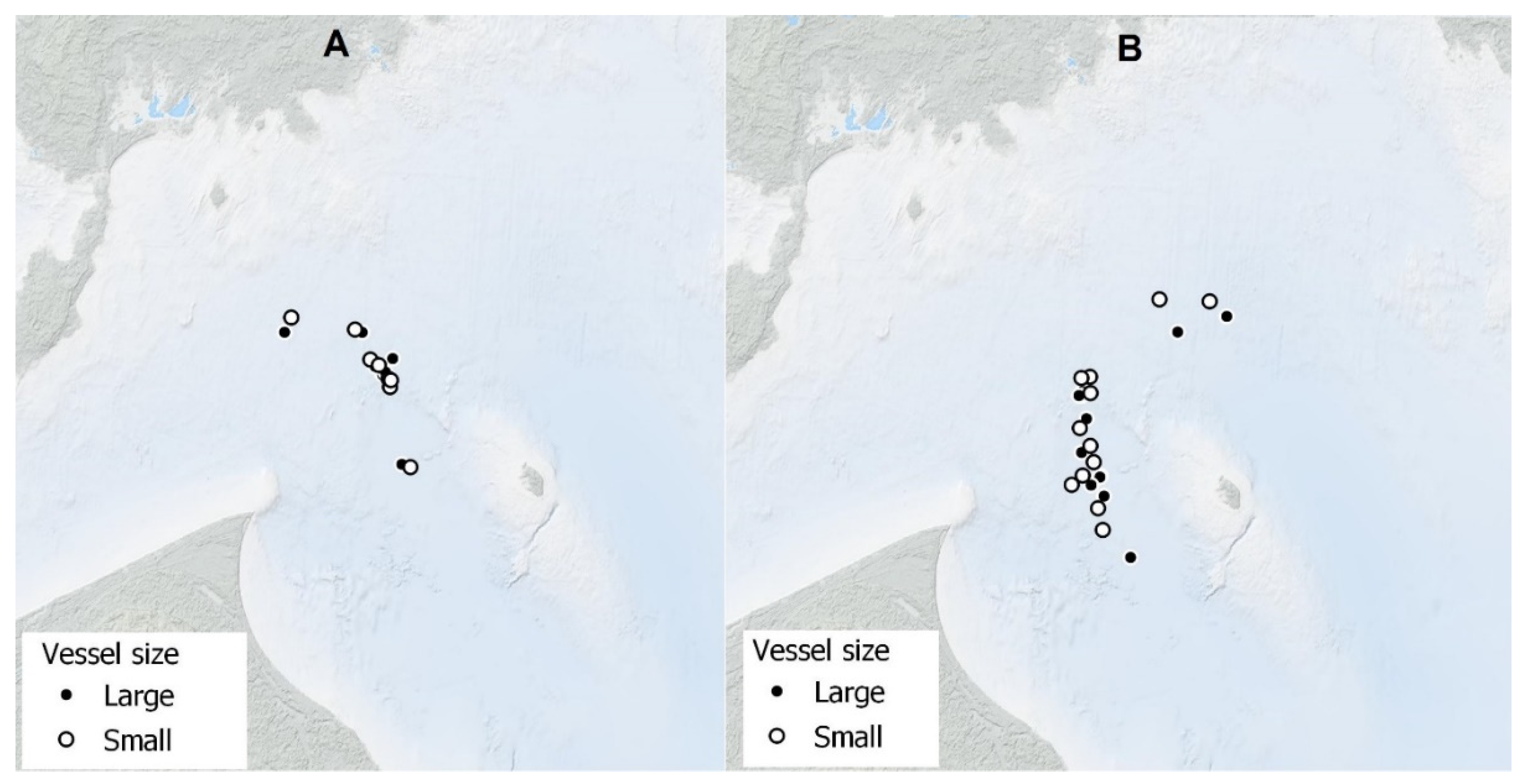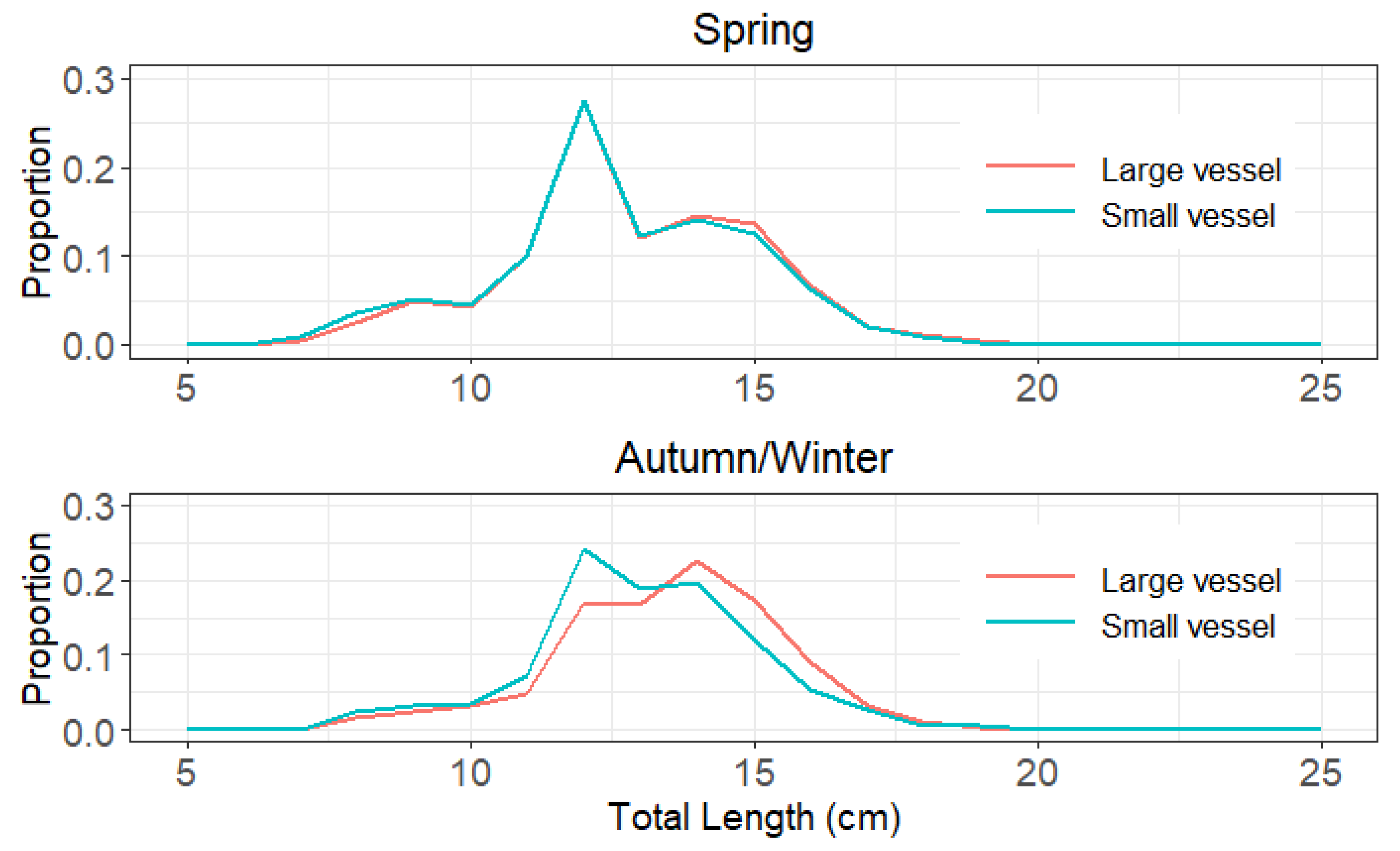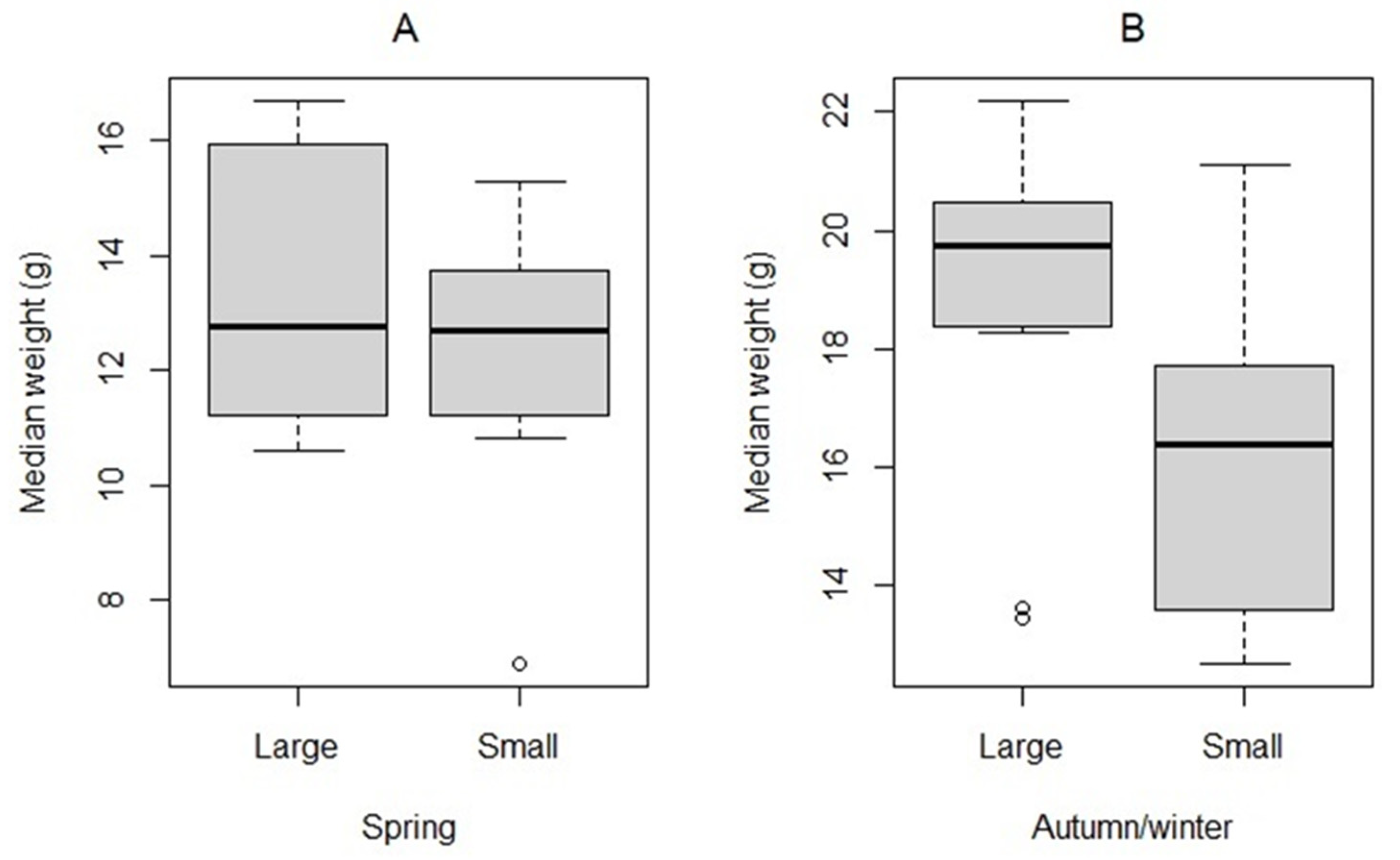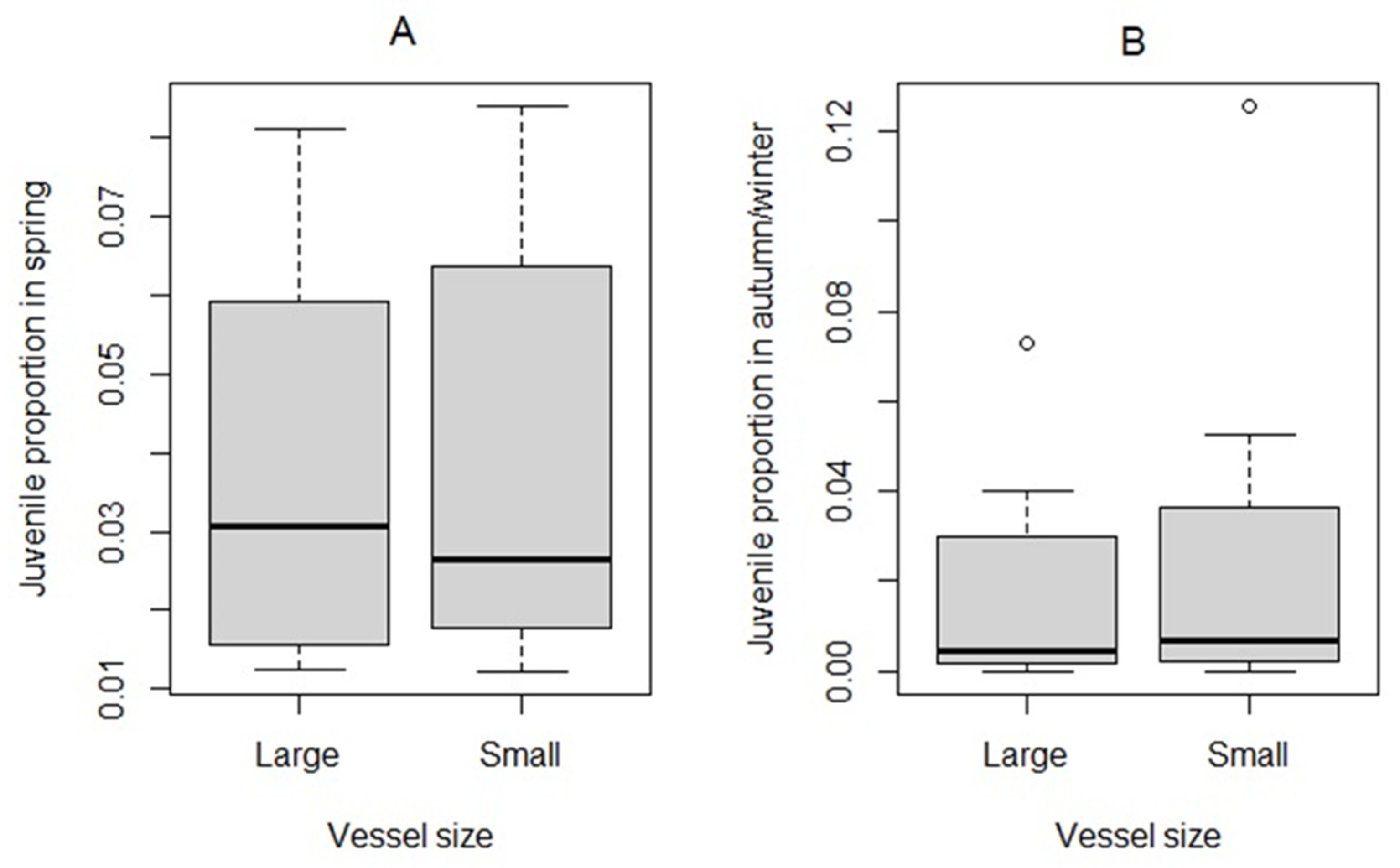Trawler Engine Size Had No Effect on Baltic Herring Size/Age Structure: An Experimental Study in the Gulf of Riga, Baltic Sea
Abstract
:1. Introduction
2. Materials and Methods
3. Results
4. Discussion
5. Conclusions
- (1)
- Easing the maximum engine power restriction of the trawl vessels in the GoR itself will most likely not have a negative impact on the sustainable management of GoR herring stock;
- (2)
- Trawl size (especially vertical opening size) should not increase with the possible introduction of larger vessels in the gulf.
Author Contributions
Funding
Institutional Review Board Statement
Informed Consent Statement
Data Availability Statement
Acknowledgments
Conflicts of Interest
References
- Bastardie, F.; Baudron, A.; Bilocca, R.; Boje, J.; Bult, T.P.; Garcia, D.; Hintzen, N.T.; Nielsen, J.R.; Petursdottir, G.; Sanchez, S.; et al. Evaluating biological robustness of innovative management alternatives. In Comparative Evaluations of Innovative Fisheries Management; Springer: Berlin/Heidelberg, Germany, 2009; pp. 119–142. [Google Scholar]
- Rosenberg, A.A.; Kleisner, K.M.; Afflerbach, J.; Anderson, S.C.; Dickey-Collas, M.; Cooper, A.B.; Fogarty, M.J.; Fulton, E.A.; Gutiérrez, N.L.; Hyde, K.J.W.; et al. Applying a new ensemble approach to estimating stock status of marine fisheries around the world. Conserv. Lett. 2018, 11, e12363. [Google Scholar] [CrossRef] [Green Version]
- Britten, G.L.; Duarte, C.M.; Worm, B. Recovery of assessed global fish stocks remains uncertain. Proc. Natl. Acad. Sci. USA 2021, 118. [Google Scholar] [CrossRef] [PubMed]
- Rahikainen, M.; Peltonen, H.; Pönni, J. Unaccounted mortality in northern Baltic Sea herring fishery—magnitude and effects on estimates of stock dynamics. Fish Res. 2004, 67, 111–127. [Google Scholar] [CrossRef]
- Suuronen, P. Mortality of Fish Escaping Trawl Gears; Food and Agriculture Organization: Rome, Italy, 2005; Volume 478. [Google Scholar]
- EU. No. 1380/2013 of the european parliament and of the council of 11 december 2013 on the common fisheries policy, amending council regulations (ec) no 1954/2003 and (ec) no 1224/2009 and repealing council regulations (ec) no 2371/2002 and (ec) no 639/2004 and council decision 2004/585/ec. Off. J. Eur. Union L 2013, 354, 22–61. [Google Scholar]
- Kuikka, S.; Suuronen, P.; Parmanne, R. The impacts of increased codend mesh size on the northern Baltic herring fishery: Ecosystem and market uncertainties. ICES J. Mar. Sci. 1996, 53, 723–730. [Google Scholar] [CrossRef] [Green Version]
- Suuronen, P.; Erickson, D.L.; Orrensalo, A. Mortality of herring escaping from pelagic trawl codends. Fish. Res. 1996, 25, 305–321. [Google Scholar] [CrossRef]
- Suuronen, P.; Perez-Comas, J.A.; Lehtonen, E.; Tschernij, V. Size-related mortality of herring (Clupea harengus L.) escaping through a rigid sorting grid and trawl codend meshes. ICES J. Mar. Sci. 1996, 53, 691–700. [Google Scholar] [CrossRef]
- Ojaveer, E. Population structure of pelagic fishes in the Baltic. Rapp. P-V Réun. Cons. Int. Explor. Mer. 1989, 190, 17–21. [Google Scholar]
- Ojaveer, H.; Jaanus, A.; MacKenzie, B.R.; Martin, G.; Olenin, S.; Radziejewska, T.; Telesh, I.; Zettler, M.L.; Zaiko, A. Status of biodiversity in the Baltic Sea. PLoS ONE 2010, 5, e12467. [Google Scholar] [CrossRef] [Green Version]
- Raid, T.; Kornilovs, G.; Lankov, A.; Nisumaa, A.-M.; Shpilev, H.; Järvik, A. Recruitment dynamics of the Gulf of Riga herring stock: Density-dependent and environmental effects. ICES J. Mar. Sci. J. Cons. 2010, 67, 1914–1920. [Google Scholar] [CrossRef]
- Raid, T.; Arula, T.; Kaljuste, O.; Sepp, E.; Järv, L.; Hallang, A.; Shpilev, H.; Lankov, A.; Dejhalla, R.; Pavletic, D. Dynamics of the commercial fishery in the Baltic Sea: What are the driving forces? In Towards Green Marine Technology and Transport, Proceedings of the 16th International Congress of the International Maritime Assotiation of the Mediterranean (IMAM 2015), Pula, Croatia, 21–24 September 2015; Taylor & Facncis Group: London, UK, 2015; pp. 897–906. [Google Scholar]
- Raid, T.; Kaljuste, O. Towards better understanding of successful management of the Gulf of Riga herring stock. Hydrobiologia 2006, 554, 131–136. [Google Scholar] [CrossRef]
- ICES. Report of the Baltic Fisheries Assessment Group (WGBFAS). ICES Sci. Rep. 2020, 2, 642. [Google Scholar] [CrossRef]
- Ojaveer, E.; Pihu, E.; Saat, T. Fishes of Estonia; Estonian Academy Publishers: Tallinn, Estonia, 2003. [Google Scholar]
- Rannak, L. On the recruitment to the stock of the spring spawning herring in the North-eastern Baltic. Rapp. P-V Réun. Cons. Int. Explor. Mer. 1971, 160, 76–82. [Google Scholar]
- Rannak, L. On the factors determining the abundance of the spring spawning herring of the Eastern Baltic. Rapp. P-V Réun. Cons. Int. Explor. Mer. 1974, 166, 145–149. [Google Scholar]
- Järvik, A.; Raid, T.; Sadul, J.-V.; Järv, L. Overexploitation of Fish Resources and Small-Scale Fisheries in the Northeastern Baltic Sea: Social Aspects of Ecosystem-Based Fisheries Management in the West Estonian Archipelago; Kruse, G.H., Browman, H.I., Cochrane, K.L., Evans, D., Jamieson, G.S., Livingston, P.A., Woodby, D., Zhang, C.I., Eds.; Global Progress in Ecosystems-Based Fisheries Management: Fairbanks, AK, USA, 2012; pp. 257–272. [Google Scholar]
- Fishing Regulations. Riigi Teataja. 2016. Available online: https://www.riigiteataja.ee/akt/128122016010?leiaKehtiv (accessed on 4 January 2022).
- Regulation (EU). Consolidated Text: Regulation (EU) 2019/1241 of the European Parliament and of the Council of 20 June 2019 on the Conservation of Fisheries Resources and the Protection of Marine Ecosystems through Technical Measures, Amending Council Regulations (EC) No 1967/2006, (EC) No 1224/2009 and Regulations (EU) No 1380/2013, (EU) 2016/1139, (EU) 2018/973, (EU) 2019/472 and (EU) 2019/1022 of the European Parliament and of the Council, and repealing Council Regulations (EC) No 894/97, (EC) No 850/98, (EC) No 2549/2000, (EC) No 254/2002, (EC) No 812/2004 and (EC) No 2187/2005. 2019. Available online: http://data.europa.eu/eli/reg/2019/1241/2021-01-01 (accessed on 4 January 2022).
- Bell, J.D.; Watson, R.A.; Ye, Y. Global fishing capacity and fishing effort from 1950 to 2012. Fish Fish. 2017, 18, 489–505. [Google Scholar] [CrossRef]
- Palomares, M.L.; Pauly, D. On the creeping increase of vessels’ fishing power. Ecol. Soc. 2019, 24. [Google Scholar]
- Pascoe, S.; Gréboval, D.F. Measuring Capacity in Fisheries; Food & Agriculture Organization: Rome, Italy, 2003. [Google Scholar]
- Marchal, P.; Andersen, B.; Caillart, B.; Eigaard, O.; Guyader, O.; Hovgaard, H.; Iriondo, A.; Le Fur, F.; Sacchi, J.; Santurtún, M. Impact of technological creep on fishing effort and fishing mortality, for a selection of European fleets. ICES J. Mar. Sci. 2007, 64, 192–209. [Google Scholar] [CrossRef]
- Eigaard, O.R.; Rihan, D.; Graham, N.; Sala, A.; Zachariassen, K. Improving fishing effort descriptors: Modelling engine power and gear-size relations of five European trawl fleets. Fish Res. 2011, 110, 39–46. [Google Scholar] [CrossRef]
- Marchal, P.; Andersen, B.; Bromley, D.; Iriondo, A.; Mahévas, S.; Quirijns, F.; Rackham, B.; Santurtún, M.; Tien, N.; Ulrich, C. Improving the definition of fishing effort for important European fleets by accounting for the skipper effect. Can. J. Fish Aquat. Sci. 2006, 63, 510–533. [Google Scholar] [CrossRef]
- Eigaard, O.R.; Marchal, P.; Gislason, H.; Rijnsdorp, A.D. Technological development and fisheries management. Rev. Fish Sci. Aquac. 2014, 22, 156–174. [Google Scholar] [CrossRef]
- Marchal, P.; Ulrich, C.; Korsbrekke, K.; Pastoors, M.; Rackham, B. A comparison of three indices of fishing power on some demersal fisheries of the North Sea. ICES J. Mar. Sci. 2002, 59, 604–623. [Google Scholar] [CrossRef]
- Ojaveer, H. Composition and Dynamics of Fish Stocks in the Gulf of Riga Ecosystem; Tartu University Press: Tartu, Estonia, 1997. [Google Scholar]
- Ojaveer, H.; Kalejs, M.V. On some oceanographic prerequisites that determine the abundance and distribution of pelagic fish in the Baltic Sea. Oceanology 1974, 14, 451–459. [Google Scholar]
- Ojaveer, E. Läänemeri. Teaduste Akadeemia Kirjastus. 2014, p. 387. Available online: http://vana.kirj.ee/10588/ (accessed on 4 January 2022).
- Dahm, E.; Wienbeck, H.; West, C.W.; Valdemarsen, J.W.; O’neill, F.G. On the influence of towing speed and gear size on the selective properties of bottom trawls. Fish Res. 2002, 55, 103–119. [Google Scholar] [CrossRef]
- Mahévas, S.; Vermard, Y.; Hutton, T.; Iriondo, A.; Jadaud, A.; Maravelias, C.D.; Punzón, A.; Sacchi, J.; Tidd, A.N.; Tsitsika, E.V.; et al. An investigation of human vs. technology-induced variation in catchability for a selection of European fishing fleets. ICES J. Mar. Sci. 2011, 68, 2252–2263. [Google Scholar] [CrossRef]
- Reid, D.G.; Graham, N.; Rihan, D.J.; Kelly, E.; Gatt, I.R.; Griffin, F.; Gerritsen, H.D.; Kynoch, R.J. Do big boats tow big nets? ICES J. Mar. Sci. 2011, 68, 1663–1669. [Google Scholar] [CrossRef]
- Manjarres-Martinez, L.M.; Gutierrez-Estrada, J.C.; Hernando, J.A. Effects of mesh size and towing speed on the multispecies catch rates of historical swept area surveys. Fish Res. 2015, 164, 143–152. [Google Scholar] [CrossRef]
- Järvik, A.; Raid, T.; Shpilev, H.; Järv, L.; Lankov, A. Precautionary approach in Baltic herring trawl fishery: The effect of hauling techniques and engine power on unaccounted mortality estimates. In Proceedings of the 12th International Congress of the Association of the Mediterranean, Lisboa, Portugal, 26–30 September 2005; pp. 1223–1330. [Google Scholar]
- Raid, T.; Shpilev, H.; Järv, L.; Järvik, A. Towards sustainable Baltic herring fishery: Trawls vs. pound nets. In Sustainable Maritime Transportation and Exploitation of Sea Resources; Taylor & Francis Ltd.: London, UK, 2011; pp. 1055–1060. [Google Scholar]
- Raid, T.; Järv, L.; Hallang, A.; Shpilev, H.; Kaljuste, O.; Järvik, A. Managing the Spatial and Temporal Pattern of Baltic Herring Trawl Fishery: A Potential Tool for Sustainable Resource Management? 2014. Available online: https://www.semanticscholar.org/paper/Managing-the-spatial-and-temporal-pattern-of-Baltic-Raid-J%C3%A4rv/ed405c85acbf35959589bcacffe098f2f1f77f45 (accessed on 4 January 2022).
- Ojaveer, E. Reproduction biology of autumn herring in the Gulf of Riga. Tr. Balt. Nautchno-Issledovatelskogo Inst. Rybn. Hozjaistva 1970, 4, 205–227. [Google Scholar]
- ICES. Report of the Workshop on Sexual Maturity Staging of Herring and Sprat (WKMSHS); Report No.: ICES CM 2011/ACOM:46; ICES: Charlottenlund, Denmark, 2011; p. 143. [Google Scholar]
- R Core Team. A Language and Environment for Statistical Computing; R Foundation for Statistical Computing: Vienna, Austria, 2021; Available online: http://www.R-project.org/ (accessed on 4 January 2022).
- Lambert, T.C. The effect of population structure on recruitment in herring. ICES J. Mar. Sci. 1990, 47, 249–255. [Google Scholar] [CrossRef]
- Arula, T.; Shpilev, H.; Raid, T.; Sepp, E. Thermal conditions and age structure determine the spawning regularities and condition of Baltic herring (Clupea harengus membras) in the NE of the Baltic Sea. PeerJ 2019, 7, e7345. [Google Scholar] [CrossRef] [Green Version]
- Rasmus Nielsen, J.; Sparre, P.J.; Hovgrd, H.; Frost, H.; Tserpes, G. Chapter 7 Effort and capacity-based fisheries management. In Developments in Aquaculture and Fisheries Science; Motos, L., Wilson, D.C., Eds.; Elsevier: Amsterdam, The Netherlands, 2006; pp. 163–216. Available online: https://www.sciencedirect.com/science/article/pii/S0167930906800104 (accessed on 4 January 2022).
- ICES. Baltic Fisheries Assessment Working Group (WGBFAS). 2021, p. 717, Report No.: 3:53. Available online: https://www.ices.dk/sites/pub/Publication%20Reports/Forms/DispForm.aspx?ID=38028 (accessed on 4 January 2022).
- Housholder, D.J. Evaluation of Harvest Control Rules: Simple One-Parameter vs. Complex Multi-Parameter Strategies. Ph.D. Thesis, The University of Bergen, Bergen, Norway, 2004. [Google Scholar]
- Zableckis, S.; Raid, T.; Arnason, R.; Murillas, A.; Eliasen, S.; Sverdrup-Jensen, S.; Kuzebski, E. Costs of management in selected fisheries. In Comparative Evaluations of Innovative Fisheries Management; Springer: Berlin/Heidelberg, Germany, 2009; pp. 191–210. [Google Scholar]






Publisher’s Note: MDPI stays neutral with regard to jurisdictional claims in published maps and institutional affiliations. |
© 2022 by the authors. Licensee MDPI, Basel, Switzerland. This article is an open access article distributed under the terms and conditions of the Creative Commons Attribution (CC BY) license (https://creativecommons.org/licenses/by/4.0/).
Share and Cite
Sepp, E.; Vetemaa, M.; Raid, T.; Arula, T. Trawler Engine Size Had No Effect on Baltic Herring Size/Age Structure: An Experimental Study in the Gulf of Riga, Baltic Sea. Fishes 2022, 7, 46. https://doi.org/10.3390/fishes7010046
Sepp E, Vetemaa M, Raid T, Arula T. Trawler Engine Size Had No Effect on Baltic Herring Size/Age Structure: An Experimental Study in the Gulf of Riga, Baltic Sea. Fishes. 2022; 7(1):46. https://doi.org/10.3390/fishes7010046
Chicago/Turabian StyleSepp, Elor, Markus Vetemaa, Tiit Raid, and Timo Arula. 2022. "Trawler Engine Size Had No Effect on Baltic Herring Size/Age Structure: An Experimental Study in the Gulf of Riga, Baltic Sea" Fishes 7, no. 1: 46. https://doi.org/10.3390/fishes7010046





